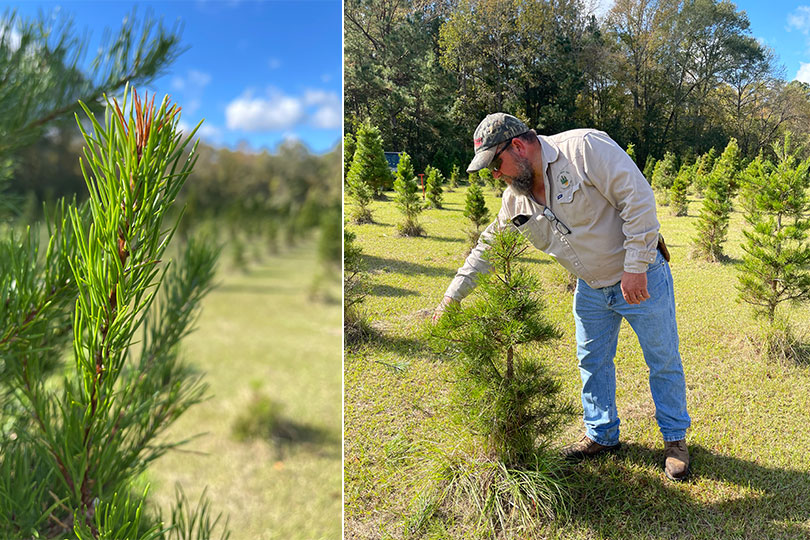By Jennifer Whitlock
Field Editor
It’s that time of year when families decorate their homes in anticipation of the Christmas holiday. And Christmas trees are the superstar of the season.
But the trees get their start years earlier in fields across the nation, including right here in Texas. So, in November, several thousand
Texas schoolchildren took a virtual field trip to see where and how Christmas trees are grown and harvested in the Lone Star State.
Each month, the students log on through Texas Farm Bureau’s (TFB’s) Farm From School program to learn more about agriculture around the state.
This semester, students learned how agriculture is always happening, even for seasonal products consumers may not see in stores outside certain times of the year.
“We’ve met with a farmer each month this semester, and the students have learned about Texas agriculture in different parts of the state. Earlier this year, they talked to a pumpkin farmer to help understand where jack-o’-lanterns come from, and last month we ‘went’ to Livingston to show them Christmas tree farming,” said Jordan Bartels, TFB associate director of Organization, Educational Outreach. “Many of them were confused at first because they associate Christmas trees with December. But we talked about how if we had waited until December, there wouldn’t be trees in the field, because they would have already been cut down to go to people’s homes and businesses.”
In Polk County, Wesley Smith has been growing Christmas trees for almost 20 years.
The sandy East Texas soil is ideal for growing Virginia pines and Carolina Sapphire Cypress trees.
Local families enjoy u-cut excursions to Double Creek Farm each fall to choose and cut their own trees. Smith also offers pre-cut assorted trees grown in Michigan, along with handmade wreaths.
The children watched as Smith displayed a pinecone and showed them where the seeds are found along the scales. There are seed orchards where pinecones are harvested for seed, Smith explained. Then, the seeds are planted in fields to create bare-root seedlings.
Smith purchases bare-root seedlings every January and plants them in fields that people harvested in the previous fall. He estimated he plants around 1,500 trees each year and has about 5,000 growing at any given time.
Students learned how Smith plants the seedlings and cares for them until they’re ready to harvest five years later. He demonstrated trimming and shaping an immature tree. Smith also gave them a glimpse of some of the machinery he uses while farming, like the tree trimmer and a spray mister he uses to keep aphids from infesting the trees that end up in people’s homes.
The main pest problem faced by Smith is deer, though. As they browse, sometimes the deer break branches on the trees and cause them to grow unevenly.
But like most Texas farmers, he’s resourceful.
“Sometimes the trees aren’t perfect, but they can be used to make Christmas wreaths,” he said. “We can take that tree, cut all the limbs off and create Christmas wreaths so they don’t have to go to waste.”
Christmas trees are recyclable, he added. So, some of them even end up as mulch in flower beds after the season is over.
The interactive Farm From School sessions allow students to ask the farmer questions. And there were plenty for Smith.
From the classroom, kids asked him about how many people work at Double Creek Farm, how the u-cut operation works and when it’s open each year.
One student asked Smith why he chose to be a Christmas tree farmer.
” I really liked the idea of families coming out and cutting trees and just enjoying that experience together,” he said. “That’s why I keep doing it.”
There is one more Farm From School session left in the semester, Bartels said. This month, students will visit a poultry farm.
“We have had such a fun semester learning about crops grown in Texas and seeing how those crops turn up in our stores and on supermarket shelves. We’re excited to wrap things up with our poultry farmers this month,” she said. “The teacher responses have been really positive. Every session, we have so many engaged classrooms and lots of deep thinking that leads to some really good questions for our farmers. We’re just delighted at how the program is working to bring agriculture to life for kids who otherwise wouldn’t have this kind of experience.”
Farm From School is currently open to all kindergarten through fifth-grade teachers in Texas for the spring semester. All that’s needed is a computer and internet access, according to Bartels.
Public, private and homeschool teachers are encouraged to register by Jan. 7. The spring semester program begins in February and runs through May.
More information on Farm From School and the registration link are available on TFB’s Ag in the Classroom webpage.

